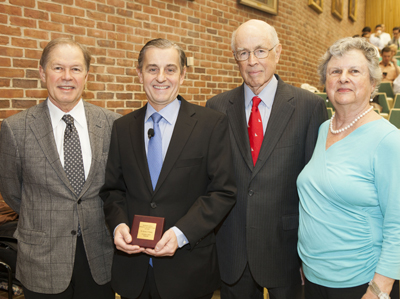Can an implanted electrical device like a cardiac pacemaker effectively treat inflammatory diseases like rheumatoid arthritis, including cases that have not responded to drug therapy?
Early clinical evidence suggests that “it very well may be possible.”
That was the message Kevin Tracey, M.D., a pioneer in the new field of “bioelectronic medicine” delivered last week during the eighth annual Meredith S. and John A. Oates Lecture in Clinical Pharmacology at Vanderbilt University Medical Center.

“The immune system is innervated and reflectively controlled, just like the heart,” said Tracey, president and CEO of the Feinstein Institute for Medical Research in Manhasset, New York. “If you really understand how those neural signals work, you can make devices that we now call bioelectronic medicines to replace drugs.”
Tracey began his quest in the late 1990s while trying to come up with a new way to block the overproduction of TNF (tumor necrosis factor), a protein messenger called a cytokine that is a major player in systemic inflammation and acute septic shock.
Monoclonal antibodies can be made to fight against TNF but the treatment can run into the tens of thousands of dollars and is effective in only one-third to two-thirds of patients.
Tracey and his colleagues at Feinstein developed a molecule that could disrupt TNF production by macrophages, a type of white blood cell. While testing the compound in the brain, in an animal model of stroke, they discovered that it also blocked TNF production by the spleen.
“This made no sense whatsoever,” he said, until they and others cut a nerve connecting the brain to the spleen, and TNF production by the spleen continued. That game-changing experiment, he said, revealed the neural circuitry underlying the inflammatory “reflex.”
By “understanding how these circuits interact to control either cytokine output or other disease endpoints,” he said, “it may very well be possible to make devices to replace drugs.”
Eventually Tracey’s scientific curiosity led him to Bosnia, Croatia and Amsterdam, where a company he established conducted in 2012 an early clinical trial of an implantable vagus nerve stimulator to block TNF production in patients with rheumatoid arthritis who had failed medical therapy.
The first patient, a truck driver in Bosnia who’d been disabled for years by his disease, within weeks was able to return to vigorous physical activity. In Amsterdam, a young woman who experienced similar results was pictured last May in a New York Times Magazine feature on the research.
Tracey, who was trained as a neurosurgeon but who has studied sepsis and inflammation for most of his scientific career, admitted he was nervous talking about an alternative to drugs to a room full of clinical pharmacologists.
But “what do drugs do?” he asked. “We spend billions trying to design molecules with this incredible specificity … so that the drug interacts with a single target.
“And then, we swallow them or we inject them and they go everywhere and … they diffuse and they persist and you get off-target side effects because as good as we can be with … this single-target approach … we lose the precision when we administer them.
“What do nerves do? If we had a device that could harness the power of a nerve, we would give electrical information, just like a nerve does, to modulate the specific release of neurotransmitters.
“These are locally active. They don’t diffuse anywhere else. They have a very short half-life. They only interact with a single organ, and they don’t have side effects.”
The question is not can bioelectronic medicines replace all drugs, he said, but which drugs can they replace? “Arguably, these are testable hypotheses now.”
The Oates lecture is named for John Oates, M.D., Thomas F. Frist Sr. Professor of Medicine, professor of Pharmacology and founding director of the Division of Clinical Pharmacology, and his wife, Meredith.












